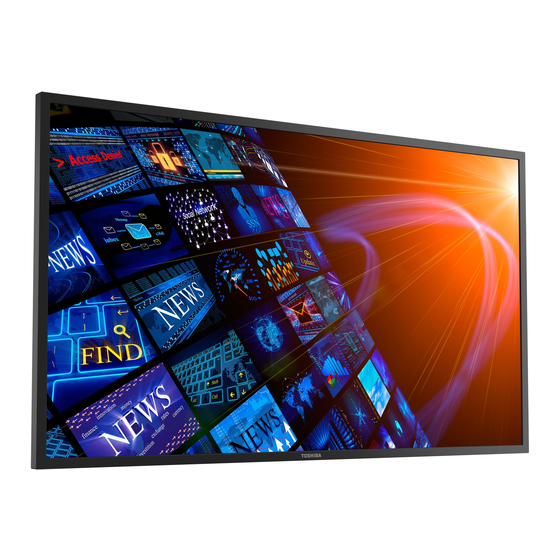
Table of Contents
Advertisement
Advertisement
Table of Contents

Summarization of Contents
Safety Precautions
Important Safety Instructions
Key safety guidelines for operation and setup.
Additional Safety Precautions
Further safety measures for specific risks.
Preparation and Maintenance
Installation Guidelines
Procedures for installing the monitor safely.
Ergonomics and Comfort
Tips for optimal user setup and comfort.
Monitor Care and Maintenance
Recommendations for keeping the monitor in good condition.
Important Monitor Notes
Discusses technical limitations of LCD technology.
Chapter 1: Introduction
Safety Icons Explained
Explains hazard warning symbols used in the manual.
Product Features Overview
Lists key capabilities of the LCD display.
Enhanced Display and Management Functions
Describes advanced display capabilities and management features.
Additional Features and Connectivity
Covers other features like DisplayPort and speakers.
Parts Name and Functions
Monitor Controls and Indicators
Identifies and describes monitor buttons and LEDs.
Wireless Remote Control Operations
Remote Control Usage and Battery Care
Details usage range, handling, and battery replacement.
Chapter 2: Preparation for Use
Installation Location and Ventilation
Guidelines for choosing placement and ensuring proper airflow.
Wall or Ceiling Mount Installation
Instructions for mounting using brackets.
Handle and Stand Frame Adjustments
Modifying handles and removing stand guide frames.
Using Wall Mount Spacers
Instructions for using spacers with wall mounts.
Portrait or Face-Up Installation
Guidelines for non-landscape orientations.
Attaching Corner Protectors
Instructions for installing protective corner covers.
Using Monitor Without Bezel
Procedure for removing the bezel.
Installing External Speakers
Instructions for connecting external speakers.
Connection Procedure Overview
General steps before making connections.
Wiring Diagram for Connections
Visual guide for connecting devices.
HDMI Cable Disconnection Prevention
Securing HDMI cables to prevent detachment.
Connecting Computer (Analog)
Steps for analog PC connection and audio.
Connecting Computer (Digital)
Steps for digital PC connection and audio.
Connecting Video Device (Component/HDMI)
Steps for connecting component/HDMI video sources.
Connecting Video Device (Composite/S-Video) & Stereo Amplifier
Steps for composite/S-video and audio connections.
Installing Expansion Module
Procedures for installing expansion modules.
Connecting OPS-Compliant Computer
Connecting an OPS computer.
Mounting OPS Computer (70-inch)
Specific mounting for 70-inch models.
Connecting for RS-232C Control
How to connect for serial control.
Connecting for LAN Network
How to connect via network.
Connecting USB Devices via USB Hub
Instructions for using the USB hub.
Connecting the Power Source
Instructions for connecting the power cord.
Chapter 3: How to Use
Powering On Monitor and Devices
Steps to turn on monitor and connected devices.
Power Management Function
Explains power saving features.
Selecting the Video Input Source
How to choose the active input source.
Controlling External Devices
Using the monitor with connected devices.
Selecting OSD Language
How to change the menu language.
Auto-Setup for Analog Inputs
Automatic screen adjustment for analog signals.
Selecting the Picture Mode
Choosing display presets.
Screen Adjustment Procedures
Manual screen size and position adjustments.
Picture Adjustment Settings
Adjusting brightness, contrast, sharpness.
Speaker Settings and Volume Control
Selecting speakers and adjusting audio levels.
Balance and Tone Adjustment
Fine-tuning audio balance and frequencies.
Schedule Setting for Operations
Programming power-on/off times.
Setting Up Operational Schedules
Detailed guide for scheduling operations.
Remote Control Methods
RS-232C Remote Control Setup
Controlling the monitor via RS-232C serial interface.
RS-232C Operation Commands
List of commands for RS-232C control.
LAN Remote Control Setup
Controlling the monitor via LAN.
Setting the USB Hub Configuration
Configuring USB upstream ports.
Configuration and OSD Operation
OSD Screen Structure Overview
Overview of OSD menu structure.
Basic OSD Screen Operation Steps
Step-by-step guide to using OSD menus.
Picture Settings Adjustments
Picture Mode Adjustments Detail
Detailed explanations of picture modes.
Color and Brightness Settings Detail
Adjusting color, temperature, and brightness.
Picture Reset and Video Detection
Resetting picture settings and video detection.
Screen Settings Adjustments
Screen Position and Zoom Settings
Adjusting image position and zoom.
Screen Resolution and Reset Settings
Adjusting resolution and screen reset.
Audio Settings Adjustments
Audio Balance, Treble, and Bass
Adjusting audio frequencies and balance.
Speaker Selection and Audio Reset
Selecting speakers and resetting audio.
PIP (Picture in Picture) Functionality
PIP Mode and Size Configuration
Configuring PIP display modes and sizes.
Configuration Settings (Part 1)
Auto Setup and Auto Adjust
Automatic display adjustments.
Power Save and Screen Saver Settings
Power management and screen saver functions.
Color System and Reset Options
Color system selection and configuration resets.
Configuration Settings (Part 2)
Serial and LAN Network Settings
Configuring communication interfaces.
Control Timeout and Monitor ID Settings
Setting control timeouts and monitor IDs.
Information OSD and Schedule Setup
Displaying information and setting schedules.
Advanced Options Menu
Input Resolution and Black Level Expansion
Adjusting input resolution and black level expansion.
Input Change and Input Detect Settings
Automatic input switching and detection.
Scan Mode and Film Mode Settings
Image display area and film mode.
ClearScan and IR Control Locking
Clear picture function and IR control locking.
Tiling and Heat Status Display
Image tiling and status display.
Power On Delay and Terminal Settings
Delaying power-on and terminal configurations.
Closed Caption and USB Upstream Selection
Caption display and USB upstream selection.
Chapter 4: Other Functions
Picture Size Options
How to adjust image aspect ratios.
Picture Mode Selection Details
Choosing display modes like High Bright, Cinema.
Control Lock Mode Functionality
Locking control buttons to prevent changes.
OSD Information Display Details
Details shown on OSD for various inputs.
Audio Input Change Options
Selecting audio input based on video signal.
Auto Brightness Control for Multiple Monitors
Collective control of auto brightness.
PIP and POP Functionality Details
Using Picture-in-Picture and Picture-Outside-Picture.
Remote Control Numbering Function
Managing multiple monitors with one remote.
Chapter 5: Troubleshooting
General Troubleshooting Steps
Initial steps to resolve common issues.
Troubleshooting Specific Issues
Covers resolution, sound, remote, and schedule problems.
Appendix A: Specifications
LCD Module Specifications
Technical details of the LCD panel.
Input/Output Signal Details
Signal types and supported resolutions.
Physical Dimensions and Weight
Size and weight specifications.
Pin Assignment Details
Analog RGB (D-SUB) Pinout
Pin configuration for D-SUB connector.
Digital RGB (HDMI/DVI-D/DisplayPort) Pinout
Pin configurations for digital inputs.
Other Connector Pinouts (S-Video, RS-232C, LAN)
Pin details for S-Video, RS-232C, LAN.











Need help?
Do you have a question about the TD-Z701 and is the answer not in the manual?
Questions and answers